8 Day Gansu Corridor Silk Road Tour from Zhangye to Dunhuang
Main Content List:
8 Days Gansu Corridor Silk Route Tour Itinerary
Day 1: Arriving in Lanzhou
Guide and driver pick you up from the airport, train station or bus terminal in Lanzhou, the capital city of Gansu province and then drive back to the downtown. If time permits, we'd like to use the free time to take a city tour in Lanzhou visiting the city's landmarks such as the Iron Bridge, Water Wheel Garden and making a relaxing walk on the prosperious Zhenning Road to feel the unique charm of Lanzhou, a city in the northwest China .
Overnight stay in Lanzhou.
Day 2: Zhangye Giant Buddha Temple and Danxia Landform Geological Park
Getting up in the early morning to go to Lanzhou West Railway Station to catch the high speed train for Zhangye. The train journey takes 3.5 hours and we arrive Zhangye in the noon.
After lunch we will firstly visit the Giant Buddha Temple which is the largest architectural relic of Gansu province built in the Western Xia Dynasty nearly 800 hundred years ago. China's largest reclining Buddha is well preserved here in this temple. The Giant Buddha is 34.5 meters long with shoulder width of 7.5 meters, leg length of 4 meters and ear length of 2 meters.
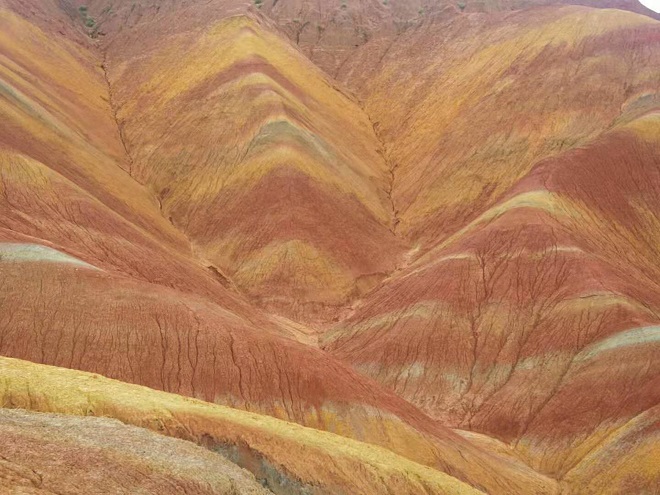
☝ Zhangye Danxia Landforms
We will then use late afternoon time to visit the Danxia Landform Geological Park which is best viewed during sunrise and sunset when colors change constantly among yellow, red, white and light gray. Time to spend in Zhangye Danxia Landform Geological Park is about 3 hours.
Overnight stay in Zhangye.
Day 3: Badain Jaran Desert
We are driving 200 kilometers northeast and spending 2 hours to get to the entrance of the Badain Jaran Desert. Upon arrival, we will change to the 4*4 Jeep to have thrilling sand-surfing in the desert.
The Badain Jaran Desert covers an area of 49,000 square kilometers. With a high-altitude location, it is one of the most beautiful desert in the world spanning in the southwest part of Inner Mongolia Autonomous Region. The desert is also home to over 100 spring-fed lakes that lie between the dunes, some of which are fresh while others are salty. We will also take you to visit world's highest stationary sand dunes - the Bilutu Peak, which is known locally as the Mountain Everest of the Desert, the Badain Lake and the Tibetan-Buddhist temple there.
Overnight stay in local farmer’s house.
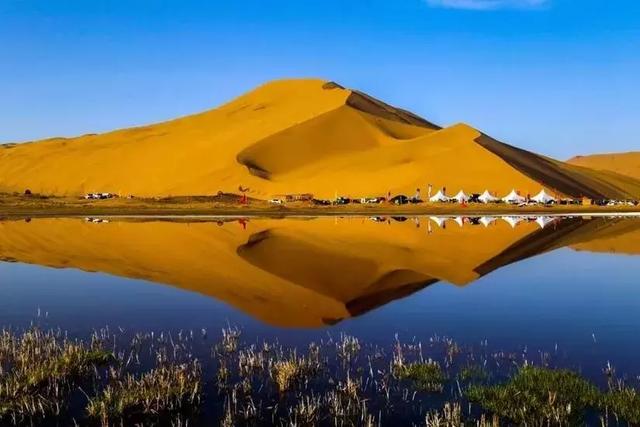
☝ Badain Jaran Desert, the most beautiful desert in the country
Day 4: Badain Jaran Desert, Mati Temple
Get up early to see the glorious sunrise, and then continue to surf in the desert, play the exciting sandboarding down the dunes. The tour will end at lunch time and we will then transfer to Alashan Youqi and drive back to Zhangye after lunch.
Remaining afternoon time, we'll go to visit the Mati (Horse' Hoof) Temple Grottoes in Zhangye. It mainly comprises Shenguo Temple, Puguang Temple, Qianfo Cave, Jinta Temple, Upper Guanyin Cave, Middle Guanyin Cave and Lower Guanyin Cave. Initially built in the Northern Liang Dynasty, Mati Temple boasts more than 70 caves and shrines. According to the legend, a horse from the heaven once left a mark of horse hooves here, and thus the temple got its name. We will come back to Zhangye downtown for lunch.
Mati Temple is 75 km away from the downtown with driving time of about 1 hour.
Overnight Stay in Zhangye.
Day 5: Jiayuguan Pass, Great Wall Museum
Spending less than 3 hours and driving 250 kilometers northwest to Jiayuguan from Zhangye in the morning. After lunch, we'll visit the famous fortress as well as the Great Wall Museum. As the west end of the Ten Thousands Li Great Wall of China, the Jiayuguan Fortress was first built in year 1372 in Ming Dynasty. it is well known as the No. 1 Impregnable Pass Under the Heaven.
Overnight stay in Jiayuguan.
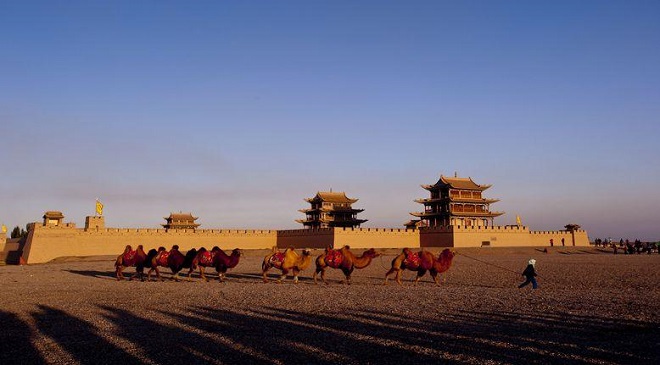
☝ Jiayuguan Fortress
Day 6: Singing Sand Dunes and Crescent Moon Spring.
Driving 5 hours west from Jiayuguan and come to Dunhuang in the morning. Today, we will pay a visit to the Singing Sand Dunes or Mingsha Mountain and Crescent Moon Spring. Singing Sand Dunes are piled up with sand in five colors of red, yellow, green, black and white. The so-called singing sand does not sing by itself, but creating singing sound when people tread or slide on the surface of the sand dunes, which is a kind of miracle of the nature. Crescent Spring is at the northern foot of the Singing Sand Dunes with the length of 118 meters from east to west and the width of 25 meters from south to north. The crescent-like lake is surrounded by the sand but it was never buried by it. The water in the lake is very clear all year around.
Overnight Stay in Dunhuang.
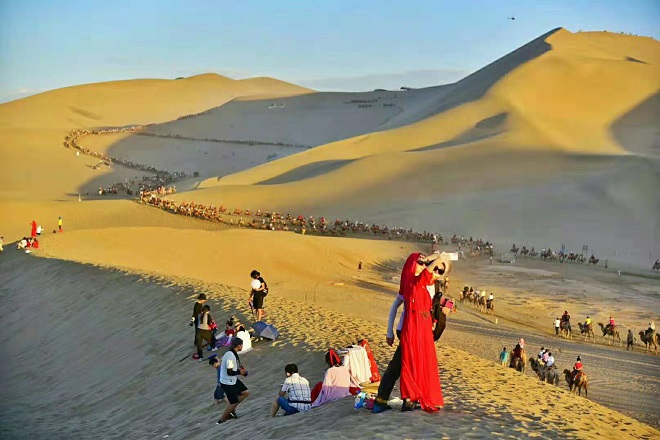
☝ Innumberous travelers are riding camels to visit the Singing Sand Dunes.
Day 7: Mogao Caves
In the morning, we will visit the UNESCO World Heritage Site - the Mogao Caves. Carved into the cliffs, the Mogao Caves in the southeast of Dunhuang oasis comprise the largest, most richly endowed, and longest used treasure house of Buddhist art in the world which represents the great achievement of Buddhist art from the 4th to the 14th century. It typically takes 2 to 3 hours to complete the Mogao Cave tour.
We will then use the afternoon time to visit Dunhuang City Museum. Even though it is small, Dunuang Museum perfectly showcases the splendid history of the ancient silk route.
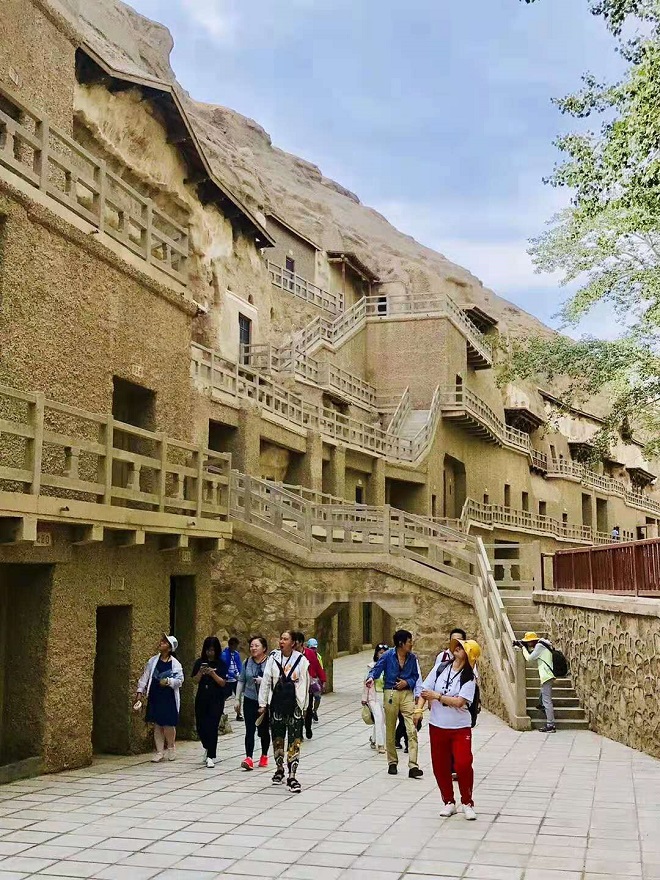
☝ Dunhuang Mogao Grottoes: where buddhism was first brought to China and monks carved amazing caves into the earth for prayer and meditation. It's forbidden to take photos inside the caves but they are really impressive! One cave holds a 26 meter Buddha!
Day 8: Dunhuang Departure/
We escort clients to the airport or train station and client leave Dunhuang, the Gansu Corridor Silk Road tour takes end.
Keywords for Silk Road Tour
Lanzhou, Gansu China→ Giant Buddha Temple in Zhangye→Zhangye Danxia Landform Geological Park→Mongolia Badain Jaran Desert → Jiayuguan Pass→Dunhuang Singing Sand Dune→Crescent Spring→ Dunhuang Mogao Grottoes→Dunhuang city Museum
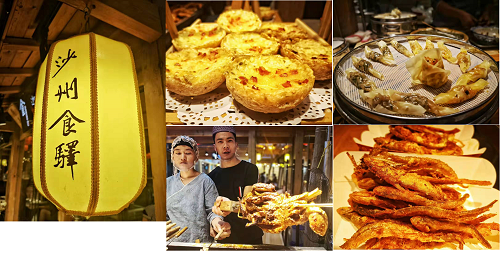
☝ We care both spiritual and physical needs of our clients and local yummy food is guranteed through the whole silk road tour.
Price
Clients have flexibility to purchase the whole tour as specified here or purchase partial and customized silk road tour. Please contact us to request a quotation as it differs with season, itinerary, number of travelers and etc.
Contact and Booking
☎ Telephone: +86-13993712727, +86-937-8865249
✉ Email: service@chinatrainguide.com, please indicate the tour code 937-101 while make enquiries.
Have you ever tried our tour guide service or do you have any suggestion? Please leave your comment here and our people will reply if necessary.

No one has commented yet. Be the first!